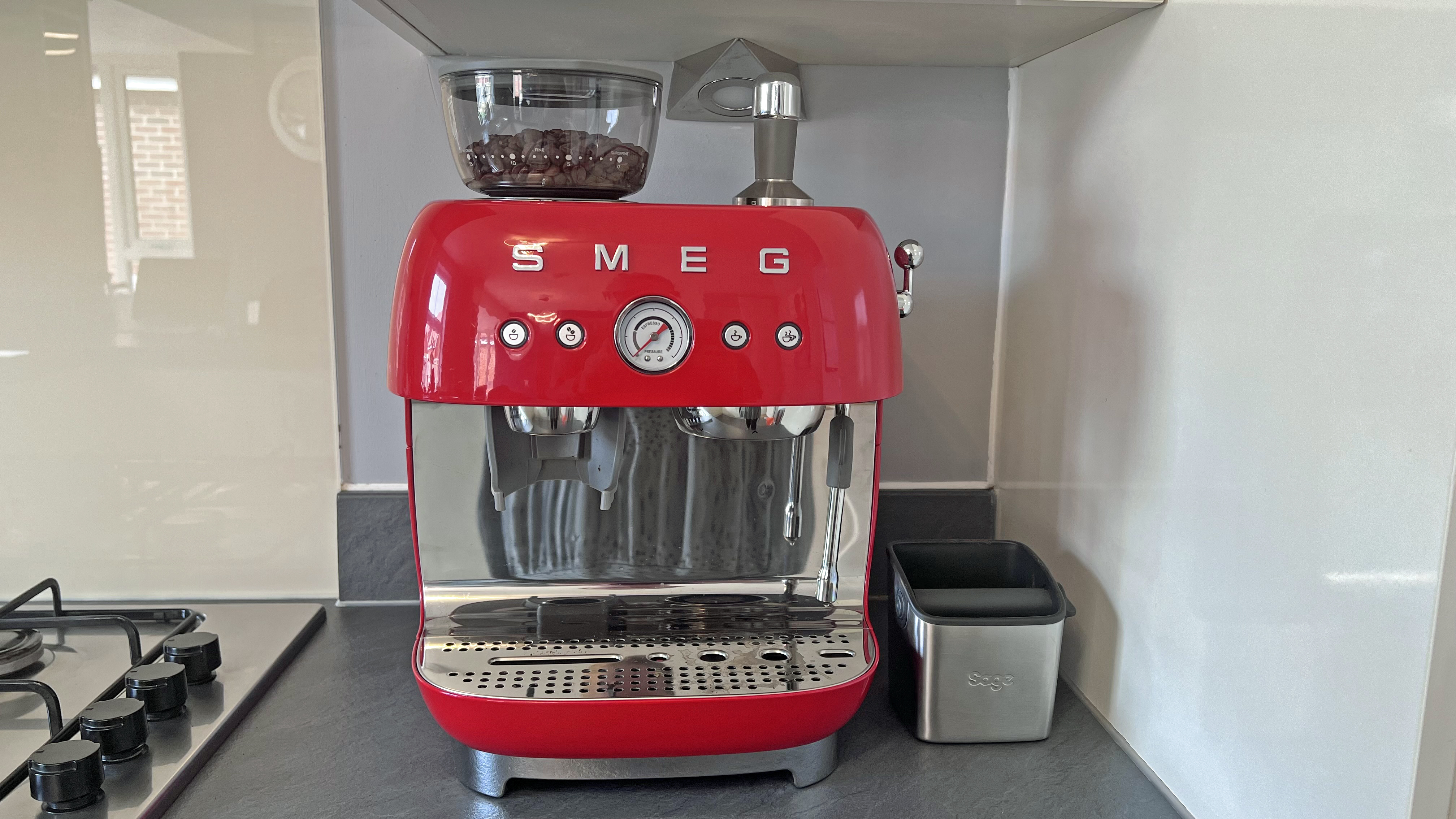Top Ten Reviews Verdict
Having been put off by its bubble-like, plastic-looking design, I held little hope of loving the Smeg Espresso Manual Coffee Machine until I made my first latte. It’s easy to use without being basic; it offers enough features to make it interesting without overwhelming; and produces barista-style coffee without needing to pass the exam. It may not appeal to coffee purists who prefer greater control over their coffee-making process, and its price point will put it out of reach of many, but for everyone else, this is the coffee machine to beat.
Pros
- +
Heats up quickly
- +
Easy-to-use controls
- +
Hot water and steam wands with dual froth levels
- +
Coffee is rich and creamy
Cons
- -
Takes up a lot of space
- -
Design won't be to everyone's taste
- -
Expensive
- -
Lacks customization options for coffee purists
Why you can trust Top Ten Reviews
Smeg has carved a particular niche in the home appliances market. Its instantly recognizable, retro-inspired designs fit a specific aesthetic, and it’s become renowned for products that don’t only stand out on style but deliver on substance. The Smeg Espresso Manual Coffee Machine looks to build on this reputation.
With its rounded edges, large 'SMEG' emblazoned across the front of the single-serve coffee maker, and (in the case of my review model) its bright red finish, it’s not designed to blend in. It’s built to be the centerpiece of your kitchen. But are its coffee-making skills as loud and impressive as they look, and more importantly, do they warrant its premium price tag?
For my Smeg Espresso Manual Coffee Machine review, I’ve spent the past month testing the machine. I’ve made a range of drinks, from iced lattes to macchiatos, and experimented with different beans.
I keep scrolling to find out if this machine is as good as I was expecting, and then head to our best coffee maker and espresso machine lineups to see how it compares.

Victoria is a freelance lifestyle and technology journalist with almost two decades of experience reviewing gadgets, beauty tech, and household appliances. She's a huge coffee fan and is signed up for multiple at-home coffee bean subscription services, which she used to put the Smeg Manual Espresso Machine through its paces.
Smeg Espresso Manual Coffee Machine: Key specs
| Row 0 - Cell 0 | Row 0 - Cell 1 |
| Model no. | #EGF03PGUS (Pastel Green), #EGF03RDUS (Red), #EGF03WHUS (White), #EGF03BLUS (Black), #EGF03CRUS (Cream), #EGF03PBUS (Pastel Blue) |
| Type of coffee | Espresso |
| Brew time | 20-30 seconds |
| Brew size options | 1 - 2.5oz (single / double espresso) |
| Water tank | 2.4L |
| Power cord length | 0.9m / 3ft |
| Average noise level | 65dB |
| Dimensions | 17.4 x 17.4 x 13.4in (w x d x h) |
| Weight | 27 lbs |
Smeg Espresso Manual Coffee Machine: price & availability
The Smeg Espresso Manual Coffee Machine is on sale for $899. It can be bought from reseller Williams Sonoma. It's not yet available to buy from Smeg.com, but it will be soon.
Score: 3 out of 5
Smeg Espresso Manual Coffee Machine: Setup
Upon unboxing the Smeg Espresso Manual Coffee Machine, its retro design and bright red gloss finish immediately clashed with my cream and gray kitchen. It looked out of place, especially alongside my other stainless steel appliances. It comes in various colors, including white, black, and cream, as well as pastel blue and green, and any of those would've worked better in my kitchen.
Sign up to receive the latest news, reviews, buying guides and deals direct to your inbox
The next thing I noticed was how heavy everything was. Not just the machine itself—which, at 27 lbs and 17.4 inches wide, is significantly heavier and bulkier than my Breville Barista Express—but the accessories, too. The portafilter and tamper are both large and weighty, the milk jug is solid, and the water tank feels larger than its 2.4L capacity would suggest.
When building the coffee machine, it's not immediately clear how all the pieces of the drip tray go together, and I had to resort to the instruction manual sooner than I would have liked. A huge plus is that the spare filter cups can be stored out of sight behind the drip tray. This way, you always have them to hand without cluttering your kitchen drawers.
A lot is going on, and it can seem overwhelming, at least initially.
Score: 3 out of 5
Smeg Espresso Manual Coffee Machine: Design
The weight and size of the Smeg Espresso Manual Coffee Machine give the appliance a luxury, premium feel. Spending this much on a coffee machine for it to feel flimsy or poorly built would be disconcerting. The materials used, mainly die-cast aluminum and stainless steel, add to the machine's overall sense of quality.
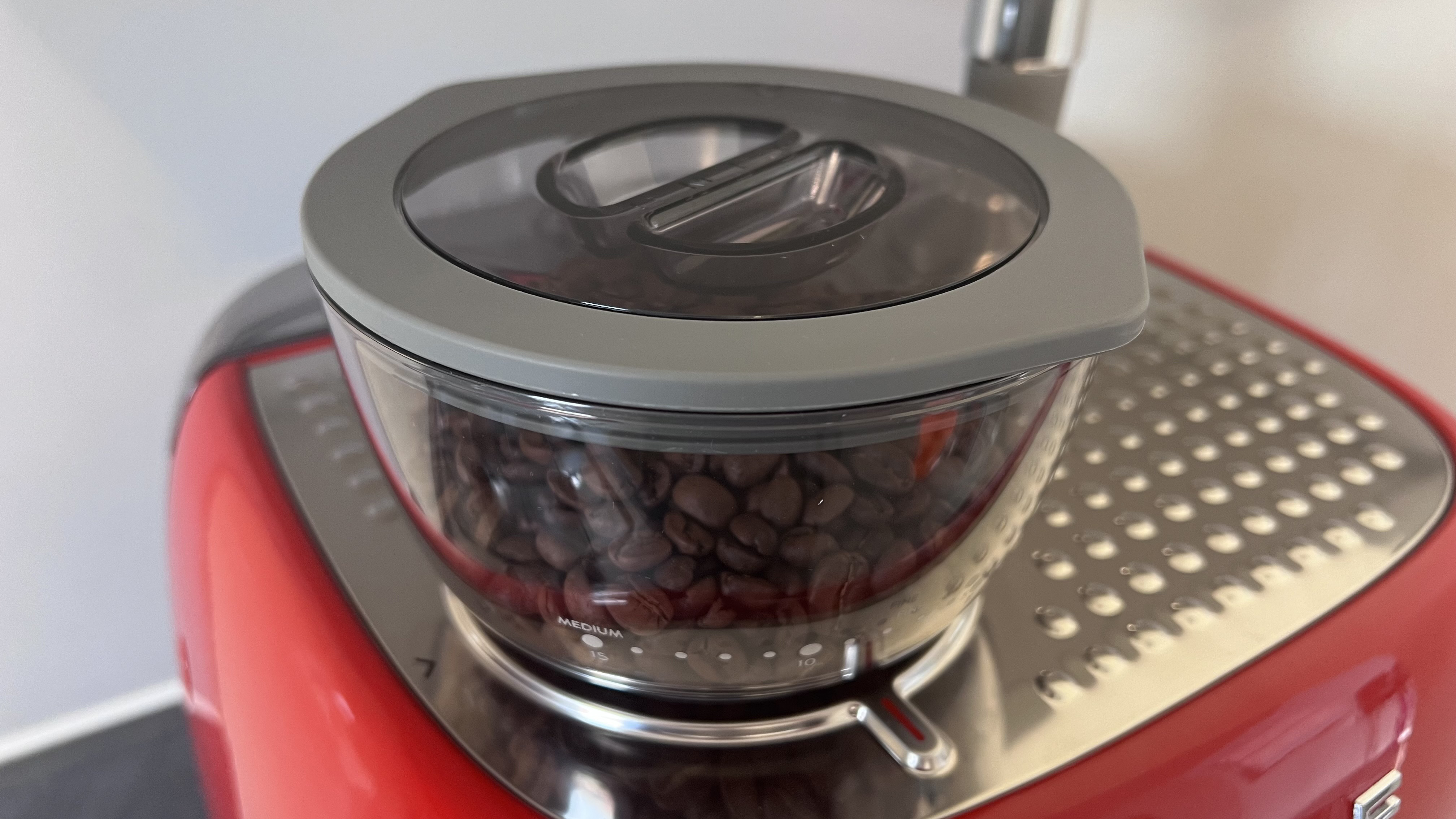
The steam/hot water wand can be adjusted from the machine or over the drip tray. There isn't much room for the milk jug and a cup to sit comfortably next to each other on this tray, so I tend to have this wand facing down and out.
The 2.4L water tank is generously sized and aimed at serious coffee drinkers rather than occasional drinkers. With its 15-stage grind size adjustments, the built-in grinder offers the kind of settings usually found on standalone grinders. This machine is targeted at coffee enthusiasts who want convenience without sacrificing quality.

That said, the buttons, levers, and settings can seem daunting. The grind settings are managed via an arrow and numbers on the grinder itself. You turn the grinder dial to the desired settings. Single and double bean buttons are on the machine's panel's left side. In the center is the espresso pressure dial, and on the right are single and double cup buttons. There is then a small handle fitted into the right side of the machine where you control the hot water and two steam controls.
Score: 4 out of 5

Smeg Espresso Manual Coffee Machine: Performance
To begin my testing, I removed the water tank, filled it with water to the maximum water line, and placed it back into the machine. This was a little fiddly because the water tank, when full, is too heavy to easily maneuver one-handed. Plus, with the coffee machine in the corner of my kitchen counter, I couldn't easily get two hands around it. That said, the tank slides in easily and clicks into place once in place.
From there, I loaded the grinder with beans—with some help from my youngest—and pressed the power button on the left-hand side of the machine. The bean buttons immediately lit up, while the LED rings around the cup-size buttons began flashing intermittently. This went on for around 30 seconds, and at first, I thought there was an error before I realized the machine was simply heating up. Once it reached the required temperature, the buttons stopped flashing, but altering the water's temperature was impossible.
When selecting a grind size, I largely had to guess and experiment on my first few uses. I also had to play around with these settings each time I used different beans to ensure the consistency and flavor were how I wanted it. This is common on bean-to-cup machines; the key is to ensure the espresso pressure sits within the set parameters for the machine in question.
As you run the water through the ground coffee, the pressure dial between the buttons on the front panel will start to rise. Your coffee should taste like an espresso if it lands in the black, highlighted section. However, adjusting the grind can help you position the dial in the center of this gauge (or wherever you want the dial to land). Ultimately, this dial's location determines the espresso's consistency and gives it a creamy finish.
This machine is a 15-bar espresso machine, which Smeg claims is the "optimum" pressure. Ideally, an 8-9 bar machine is optimal, but it's difficult to achieve such bars on at-home machines. The conditions must be right to manage these lower bars, so 15-bar machines are the next best for home brewing.
To turn the beans into ground coffee, you first need to check which filter you're using – the single or double filter – before resting the portafilter in the grey plastic holder and pressing the corresponding single or double bean button. The machine grinds the coffee into the filter, and you then use the tamper to compress the grounds. From here, turn and lock the portafilter in place, press the corresponding cup size button, and make sure you place a cup underneath.
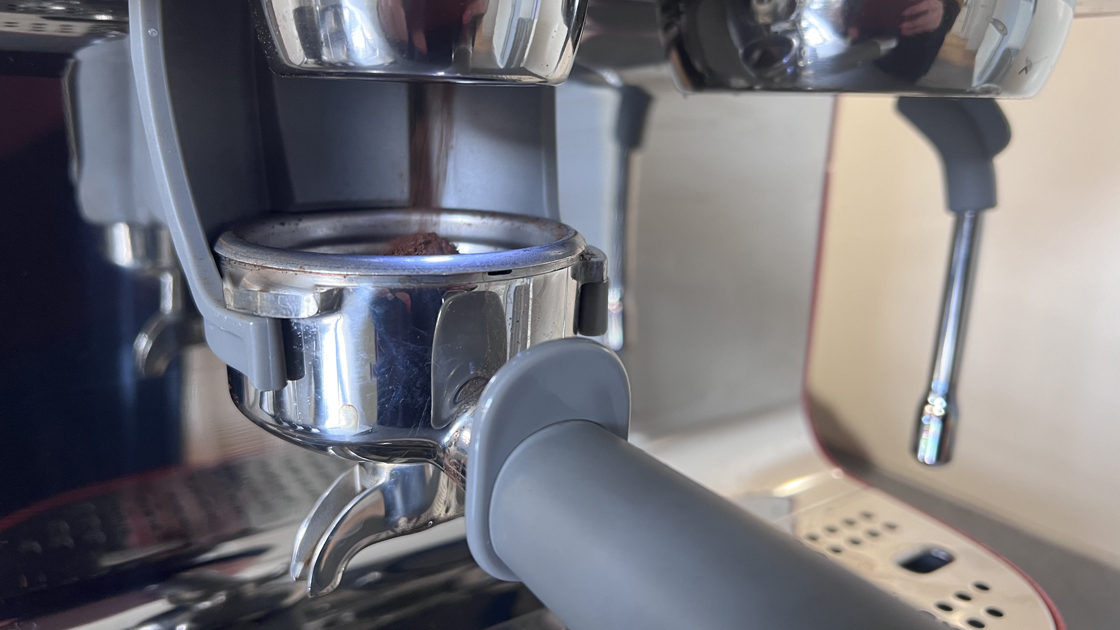
Once made, the fun begins. You can drink the espresso as is, fill it up with hot water for an Americano, froth the milk in the jug with either of the steam settings for a cappuccino, pour the espresso over ice, and more.
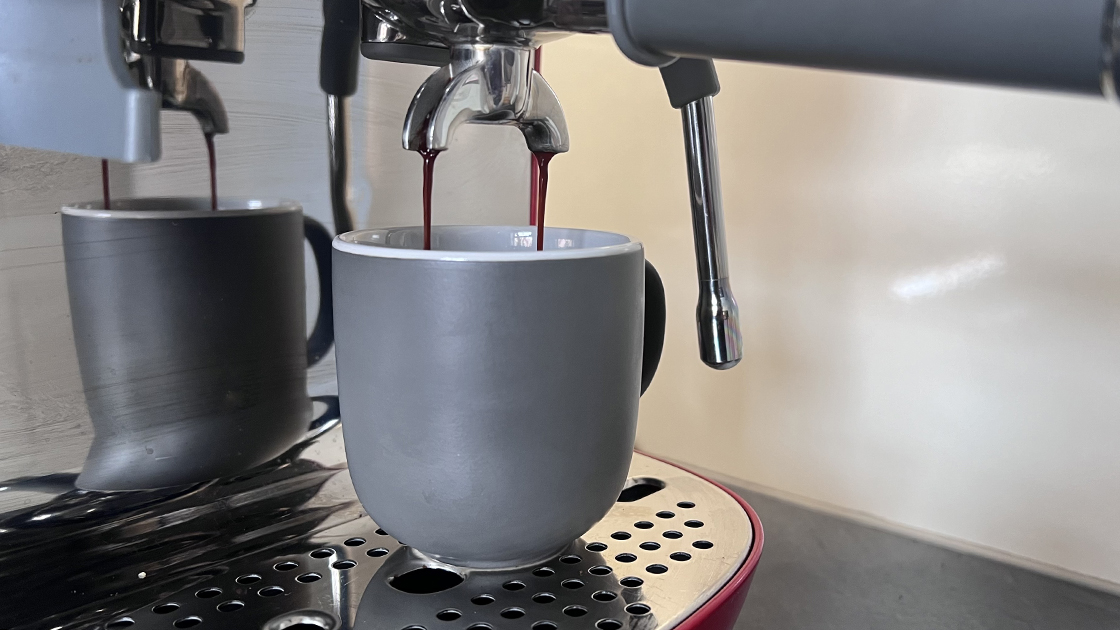
For my taste, the hot water from the machine isn't as hot as I like, so I use water from the kettle instead. Similarly, the low steam function froths the milk to my liking, so I haven't found myself needing or using the high steam option. They're nice features; I just didn't find them useful.
A couple of additional things to note – the Smeg coffee machine is significantly quieter than every other coffee machine I've tested, especially my Breville Barista Express. My youngest son used to cover his ears when I ground coffee on the Breville model, but he doesn't even notice when I do the same on the Smeg machine. You can go from using the hot water wand straight to steam immediately elsewhere. This isn't always the case with machines of this type, and it makes a noticeable difference in time and convenience.
The machine's manual nature means that there is a learning curve involved, and it has flaws. The limited adjustability in coffee quantity and espresso volume—only being able to choose between a standard single or double—means you may have to experiment to find your ideal brew. In my experience, though, this is more than worth the effort.
Score: 5 out of 5
Smeg Espresso Manual Coffee Machine: Taste test
When it comes to the actual taste of the coffee, the Smeg Espresso Manual Coffee Machine comes into its own.
The built-in grinder allows you to use freshly ground beans each time, guaranteeing a stronger and fresher taste. The machine's high water pressure and adjustable grind settings help you make a rich, full-bodied espresso, albeit with a little experimentation.
Reviews
Bosch TQU60703 800 Series VeroCafe Espresso Machine review: a smart coffee maker that can do it all
Casabrews 5700Pro Espresso Machine review: an all-in-one espresso machine with a learning curve
Jura E8 review: the best-selling bean-to-cup coffee maker from the brand
De'Longhi TrueBrew Drip Coffee Maker review: truly a marvelous brewing experience
De'Longhi Eletta Explore review: a bean-to-cup coffee maker with hot and cold brew options
L’OR Barista Coffee & Espresso System review: espresso shot or cup of coffee?
Once you've found your ideal settings, the Smeg Semi-Automatic Espresso Machine consistently produces cup after cup of great-tasting coffee. The large water tank and bean hopper also mean you can entertain guests or get through a busy morning – or cope with a late night – without constantly having to refill the machine.
The steam wand's two froth levels offer versatility in milk texturing. This means you can go from a super frothy cappuccino to a smoother, flat white, although in reality, I found the lower setting was enough to create a mix of textures on its own.
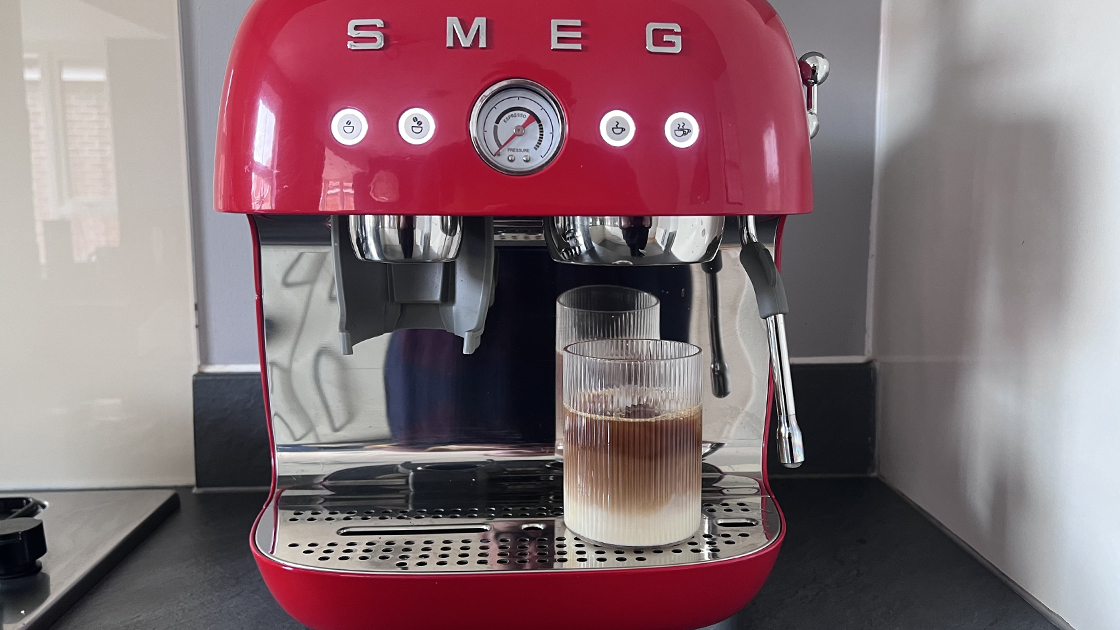
Should you buy the Smeg Espresso Manual Coffee Machine?
| Attribute | Notes | Score |
|---|---|---|
| Price & availability | It's high price and limited availability make this a somewhat exclusive product. | ★★★ |
| Design | Iconic Smeg look and sturdy design works well but is an acquired taste. | ★★★★ |
| Performance | Learning curve is more than worth the effort for taste and quality. | ★★★★★ |
Buy it if...
You want style and substance
The Smeg Espresso Manual Coffee Machine is not just a pretty face; it's a high-performing machine that consistently delivers great-tasting coffee.
You don’t like refilling the water tank every day
The water container is fairly large, so you could make multiple espressos in a row without refilling it. One full tank usually lasted me about three days, despite making multiple coffees for myself and my partner daily.
You want a built-in grinder
The convenience of having a grinder and espresso machine in one not only saves time, space, and washing up, but it also means the grind of the beans is designed to be optimized by the water pressure—a small but significant benefit when it comes to getting great-tasting coffee.
Don't buy it if...
You want more control
The Smeg coffee machine offers enough customization settings for most people, but if you're a coffee aficionado, you may find it too restrictive.
You're on a budget
This machine has a hefty price tag, making it a significant investment. You'll likely only get good value from it if you like and make coffee regularly but don't want the hassle of complicated settings.
You don’t have a lot of counter space
The Smeg Espresso Manual Coffee Machine is bulky and will take up considerable room, so it may not be suitable for smaller kitchens or cluttered countertops. Its design is also an acquired taste.
How does the Smeg Espresso Manual Coffee Machine compare?
The Smeg Espresso Manual Coffee Machine is not to be confused with Smeg's other older coffee machines.
The Smeg ECF01 is the brand's original manual espresso coffee machine. It's half the size of the Semi-Automatic and is missing the grinder—so you need to buy ground coffee rather than beans—but it does come with a milk frothing wand and multiple espresso sizes. It was recently succeeded by the upgraded but largely identical ECF02, which retails for $530.
Then there's the Smeg BCC02, a bean-to-cup machine with a steam wand on the front and the grinder built into its slim base. It sells for $995.
When looking at alternative machines outside of Smeg, the Breville Barista Express Impress costs $700 and offers similar functionality and features. With 25 grind settings and an in-built tamper versus Smeg's 15 settings and a separate tamper, the Breville model may be a better option for coffee purists or people who want more customizability.
How I tested the Smeg Espresso Manual Coffee Machine
- Used the machine to make an espresso every morning and afternoon for a month
- Spent time trying out the different portafilters, grind settings, and wands
- Tweaked quantities to get the best results
I tested the Smeg Espresso Manual Coffee Machine at home in Aylesbury, UK, for a month. I made at least one, sometimes two, espressos or espresso-based coffees daily and tested various beans from different brands. I experimented with different grind settings and made different types of coffee.
Read more about how we test.
- First reviewed: September 2023

Victoria Woollaston, with nearly 20 years of experience, has reviewed gadgets, beauty tech, and household appliances for WIRED, TechRadar, and Expert Reviews. She specializes in critiquing coffee makers and small appliances for Top Ten Reviews. Victoria is also the founder and editor of inclusive beauty and grooming sites mamabella and MBman.
